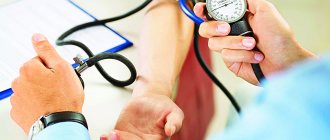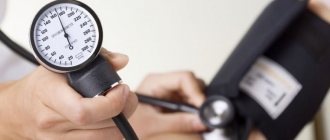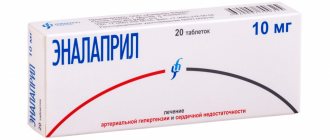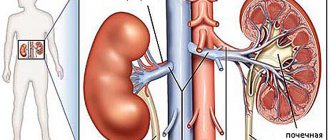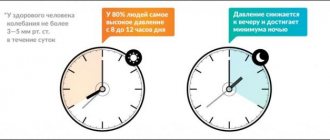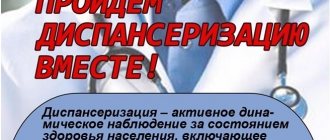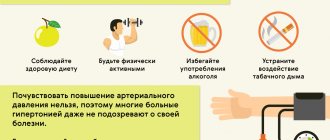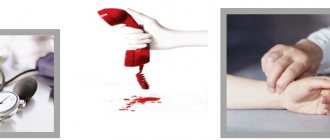The most practical gift for a 50th birthday is a blood pressure monitor. After all, it is at this age that the need for constant monitoring of blood pressure arises. And even if you have not previously had time to acquire such entries in your medical record as coronary heart disease, angina pectoris and atherosclerosis, hypertension can appear due to a number of anatomical and physiological changes:
- With age, the walls of blood vessels lose their elasticity and functionality;
- The level of cholesterol in the blood increases, characteristic plaques accumulate, narrowing the lumen of blood vessels;
- Blood viscosity increases;
- Kidney pathologies lead to excessive synthesis of vasopressin and renin, hormones that increase blood pressure;
- Sustained disturbances in the functioning of the autonomic nervous system occur, which also leads to increased blood pressure;
- Often the reasons lie in the “wear and tear” of the endocrine system. Disorders of the adrenal glands and thyroid gland also create the preconditions for increased blood pressure.
Medications for high blood pressure in the elderly should be selected comprehensively, based on medical history and probable causes of its increase. As a rule, treatment with one drug brings a positive effect only in the early stages of hypertension; later, doctors offer complex therapy with drugs of 2-3 groups.
Therefore, it is impossible to answer unequivocally which blood pressure medicine is best for the elderly: only cardiologists or local therapists should select it, rating of doctors with verified reviews.
Drugs to lower blood pressure in older people: their types and groups
Every hypertensive patient’s first aid kit should have at least two drugs to lower blood pressure: fast-acting and long-acting. The former are necessary for the rapid relief of sharply increasing hypertension, the latter - for continuous use. Drugs of the first group belong to ACE inhibitors and have a number of advantages:
- Availability and low cost - every pharmacy has them;
- Recommended for coronary heart disease, because they improve blood supply to the myocardium and reduce the risk of heart attack;
- Reduces blood viscosity and prevents the formation of blood clots.
Long-acting drugs
In case of arterial hypertension of 2-3 degrees, elderly people are prescribed constant therapy with long-acting drugs. They are more convenient to use - you only need to take 1-2 times a day, they have a milder effect and a cumulative effect. After 2-3 weeks of constant use, stabilization of the condition and absence of pressure surges are observed.
The mechanism of action of the drugs is based on blocking angiotensin receptors, a powerful vasoconstrictor hormone that is produced in every body. In this case, the patient is not at risk of sudden drops in pressure, dizziness and weakness:
- The drug is well tolerated by most patients, side effects occur in 1% of cases;
- Provides a sustainable effect throughout the day - it is enough to take once a day before meals;
- Does not require an accumulation effect - begins to act within 6 hours.
The only significant drawback of drugs in this group is their high cost.
What to pay attention to when taking medications?
Arterial hypertension in an older person is not only an increase in blood pressure, but also resistance of the walls of arterioles, narrowing of their lumen, damage to the endothelium with almost irreversible changes in its structure.
“Aggressive” reduction of blood pressure to the target level leads to a number of side effects:
- dizziness;
- unsteadiness, uncertainty in gait;
- general weakness;
- heartbeat;
- feeling of lack of air.
These phenomena significantly reduce the patient's adherence to treatment.
A blood pressure medicine for older people should combine several qualities: high efficiency with minimal doses, a gentle reduction in blood pressure, a small number of contraindications, ease of use and an affordable price. Foreign drugs of the new generation meet these criteria, but, unfortunately, they are more expensive compared to domestic analogues.
Tablets for high blood pressure for elderly patients are selected taking into account accompanying diseases.
| Concomitant pathology | Recommended | Limit use |
| ZSN | Diuretics, ACE inhibitors, sartans, BB (with slow dose selection) | AA, AK, "Hydralazine" |
| IHD | BB, AK, ACE inhibitors, sartans | "Hydralazin", AA |
| Cerebral blood flow disturbance | Diuretics, ACE inhibitors, sartans, dihydropyridine AKs | "Reserpine", "Dopegit", "Clonidine" |
| chronic renal failure | Loop diuretics, AK, "Dopegit" | Thiazide diuretics, AA. Use ACE inhibitors and sartans with caution (monitoring GFR) |
| COPD | Diuretics, AK, sartans | With caution - BB. ACE inhibitors sometimes cause cough. |
| Gout | ACEI, sartans, AK | Diuretics |
| Albuminuria, proteinuria | ACE inhibitors, sartans, AK, Moxonidine, Urapidil | BB, thiazide diuretics, Clonidine |
| Diabetes | Sartans, ACE inhibitors, AK, Moxonidine, Urapidil | BB, thiazide diuretics, Clonidine |
| Peptic ulcer of the stomach and duodenum | Diuretics, sartans, ACE inhibitors | "Reserpine", BB |
Elderly patients are forced to take a regimen of two, three or even four antihypertensive drugs to adequately control blood pressure.
Therefore, several recommendations for the use of medications should be followed:
- At your doctor's appointment, tell him about all the pills you are taking.
Some drugs weaken the effect of antihypertensive drugs (non-steroidal anti-inflammatory drugs, vasoconstrictor nasal drops, corticosteroids, herbal medicines).
- On a separate sheet of paper, write down the entire list of medications that need to be taken every day and keep it in a visible place.
- Leave a reminder to take pills on your mobile phone.
- Keep a blood pressure diary. Measure blood pressure two to three times a day at the same time. These records will help the doctor choose the optimal treatment regimen.
- Before using each, read the instructions. Pay special attention to side effects and symptoms of overdose.
- It is optimal to divide the medications into two doses (in the morning and before bed). This facilitates 24-hour blood pressure control, especially during dangerous night hours.
- Take medications regularly. If you miss the time, do not double the dose.
- Do not replace medications, their dosage or frequency of use on your own.
- If side symptoms appear, consult a doctor immediately.
- Get medical examinations regularly. Monitor heart, liver and kidney function.
Symptoms requiring medical attention:
- a sharp decrease in blood pressure with nausea, dizziness, darkening of the eyes;
- bradycardia;
- pain in the pericardial region, shortness of breath;
- the appearance of arrhythmia, tachycardia;
- sudden deterioration of vision;
- swelling of the legs;
- decreased amount of urine;
- dry obsessive cough;
- subcutaneous hemorrhages, nosebleeds;
- allergic rash;
- nausea, abdominal pain, change in stool color.
To achieve the best effect, hypertensive patients are recommended to use non-drug treatment methods:
- eat rationally, lose weight;
- limit the amount of salt;
- spend a lot of time in the fresh air, walk, do morning exercises;
- exclude alcohol, tobacco and caffeine;
- minimize stress levels.
Diet is another effective way to reduce blood pressure
A diet for high blood pressure in old age is comparable to the effect of long-acting medications: if the patient is disciplined and carefully monitors the diet, it can bring stable results.
At the same time, it does not require large investments and exotic products; you can follow the recommendations even on a very modest budget:
- The first thing to do is limit your salt intake. After all, the sodium contained in it helps to increase blood pressure and remove potassium from the body, which is necessary for the functioning of the heart. Please note that spices are not prohibited - pepper, coriander, parsley will help eliminate the effect of bland food and taste hunger.
- The No. 1 enemy for older people is cholesterol. A lot of it is found in the yolk of eggs, chicken skin and fatty, red meat. It is better to reduce the consumption of these products to a minimum and give preference to white meat - chicken breast, rabbit, and sea fish. The unsaturated fatty acids it contains displace cholesterol from biochemical processes and help increase the elasticity of blood vessels.
- What foods reduce blood pressure in old age? Sometimes you can find whole lists: bananas, avocados, leafy vegetables, asparagus, beets and many others. The fact is that they are all rich in potassium, a microelement that supports the proper functioning of blood vessels, the heart and the nervous system.
Thus, the diet to reduce blood pressure is simple: you need to exclude salty, fried and pickled foods, minimize the amount of salt and give up fatty meat. An abundance of vegetables, fruits and grain products will help maintain normal blood pressure.
Exercises to lower blood pressure for the elderly
Staying physically active is a very important aspect. Moderate loads keep the walls of blood vessels toned, promote normal heart function and eliminate congestion. In this case, preference is given to so-called aerobic exercises or cardio exercises - walking in the park, jogging, climbing stairs, yoga and breathing exercises. You need to choose from this list in accordance with the age and condition of the elderly person.
An important principle is to control your heart rate when performing exercises. Traditionally, it is calculated using the formula: 220 - the patient’s age. Thus, for a 70-year-old patient, the number of heartbeats during exercise should not exceed 150 times per minute. If the pulse steadily reaches its maximum, the optimal solution is to switch to deep and slow breathing, while inhaling through the nose and exhaling through the mouth.
A healthy lifestyle and diet are a great help for normalizing blood pressure. But you shouldn’t rely only on them in adulthood - you should definitely consult a doctor to select reliable medications.
Features of the treatment of hypertension in old age
Hypertension (HT) belongs to a group of diseases that require lifelong treatment.
High blood pressure (BP) is registered in 50-70% of elderly people. More attention should be paid to PAP - pulse pressure (the difference between SBP and DBP). An increase in this indicator of more than 50 mm Hg. Art. indicates an increase in the stiffness of the arterial wall. Such vessels interfere with normal blood flow and provoke the development of left ventricular hypertrophy, coronary circulatory failure, ischemic brain damage and disease resistance to drugs.
A gradual increase in SBP with stabilization or decrease in DBP occurs as the duration of headache increases, changing its hemodynamic structure, and acquires the features of isolated systolic hypertension (ISH).
Factors influencing the course of hypertension in old age:
- dysfunction of baroreceptors, sympathetic regulation;
- renal dysfunction;
- work of the renin-angiotensinaldosterone system (RAAS);
- disruptions in the hypothalamus-pituitary-adrenal cortex axis;
- pronounced structural changes in the aorta and its main branches;
- violation of metabolic processes.
HD in older people is characterized by a number of features:
- A high frequency of “pseudohypertension” is a discrepancy between the actual intraarterial pressure measured using the Korotkoff method. As a result of sclerotic processes in the vessels, blood pressure readings obtained using a tonometer do not coincide with the actual ones, which serves as a basis for prescribing untimely treatment.
- High blood pressure lability. It significantly worsens the quality of life, forcing the patient to constantly expect an increase or decrease in indicators, disrupts the regimen of taking antihypertensive drugs, and reduces confidence in the doctor and the treatment prescribed by him. Patients with high blood pressure lability are much less able to tolerate a decrease in pressure, accompanied by cardiocerebral syndrome (dizziness, headaches, drowsiness, palpitations, unsteadiness of gait).
- Increased sensitivity to salt. Renin activity gradually decreases with age. This leads to a good result in the treatment of hypertension with diuretics.
- Changes in autonomic regulation of cardiac activity. The sensitivity of the myocardium to adrenaline increases, which causes the development of rhythm disturbances and ischemic heart lesions in response to even minor excitement or physical stress. With age, the number and sensitivity of β2-adrenergic receptors decreases, which causes an imbalance between the lumen of the vessel in the form of narrowing or dilatation towards spasm. Over time, the autoregulation of cerebral, renal and coronary circulation changes. This leads to an increase in vascular resistance and a decrease in sensitivity to antihypertensive pills.
Sclerotic processes in the cerebral arteries, narrowing of their diameter and thickening of the walls lead to a deterioration in the adaptation of cerebral hemodynamics to reduced blood pressure. In older patients, hypertensive dementia (subcortical white matter atrophy) develops and the risk of stroke increases. Additionally, the prognosis is worsened by atherosclerosis of the carotid arteries and osteochondrosis of the cervical spine.
In the treatment of arterial hypertension (AH) in the elderly, special attention is paid to renal function. Even a slight impairment of filtration capacity leads to an even greater increase in blood pressure.
Kidney damage in hypertension progresses slowly and unnoticeably. Only in the later stages do clinical symptoms appear, when it becomes much more difficult to correct the disorders.
Increased activation of the RAAS leads to hypertrophy of the muscular layer of the arterial wall and proliferation of connective tissue. As a result, renal tubular atrophy occurs, which is manifested by high levels of creatinine, serum urea and symptoms of chronic renal failure (CRF).
Therefore, for elderly patients, before starting hypertension therapy, the following should be determined:
- protein in urine;
- glomerular filtration rate (GFR);
- plasma concentrations of creatinine and urea.
